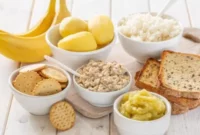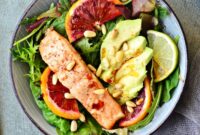South Beach Diet Overview: This guide delves into the popular South Beach Diet, exploring its core principles, three-phase structure, and comparison to other weight-loss methods. We’ll examine the allowed and restricted foods, the rationale behind these choices, and the diet’s impact on various macronutrients. Furthermore, we’ll discuss exercise recommendations, lifestyle modifications, potential benefits, risks, and strategies for long-term success.
Understanding the South Beach Diet involves more than just a simple list of foods to eat and avoid. It’s a holistic approach that considers the glycemic index, insulin response, and the overall impact of food choices on weight management and long-term health. This overview will equip you with the knowledge to make informed decisions about whether this diet is a suitable option for your individual needs and goals.
Food List & Restrictions
The South Beach Diet distinguishes itself through its phased approach to food intake, carefully managing carbohydrate consumption to regulate blood sugar and insulin levels. This approach aims to promote sustainable weight loss and improved metabolic health. Understanding the allowed and prohibited foods in each phase is crucial for successful implementation.
Phase 1 Food List and Restrictions
Phase 1, the most restrictive phase, focuses on eliminating high-glycemic index carbohydrates and unhealthy fats. This initial restriction is designed to jumpstart weight loss and improve insulin sensitivity.
- Allowed Foods: Lean proteins (fish, poultry, lean meats), healthy fats (olive oil, avocados, nuts), non-starchy vegetables (broccoli, spinach, peppers), eggs, and limited amounts of low-glycemic fruits (berries).
- Prohibited Foods: Sugary drinks, processed foods, white bread, pasta, rice, potatoes, most fruits (except those listed above), and unhealthy fats (saturated and trans fats).
The rationale behind these restrictions lies in the glycemic index (GI) and the subsequent insulin response. High-GI foods cause rapid spikes in blood sugar, leading to increased insulin secretion. This insulin surge can promote fat storage and hinder weight loss. By restricting high-GI foods in Phase 1, the diet aims to stabilize blood sugar, reduce insulin resistance, and encourage the body to utilize stored fat for energy. The emphasis on lean protein and healthy fats supports satiety and helps maintain muscle mass during weight loss.
Phase 2 Food List and Restrictions
Phase 2 gradually reintroduces some healthy carbohydrates, focusing on those with a lower glycemic index. This phase aims to maintain weight loss while increasing dietary variety and flexibility.
- Allowed Foods: All foods allowed in Phase 1, plus whole grains (in moderation), some higher-fiber fruits (apples, pears), and certain legumes (lentils, chickpeas).
- Prohibited Foods: Foods high in refined sugars, saturated and trans fats, and processed foods remain restricted. The focus is still on minimizing high-GI carbohydrates.
The controlled introduction of low-GI carbohydrates in Phase 2 is crucial. These carbohydrates provide sustained energy without the same dramatic blood sugar spikes as their high-GI counterparts. This approach helps maintain stable energy levels and prevents the cravings that can derail weight loss efforts.
Phase 3 Food List and Restrictions
Phase 3 represents a transition to a more sustainable, long-term eating plan. The emphasis shifts to mindful eating and portion control.
- Allowed Foods: A wider variety of foods are allowed, including more whole grains, fruits, and healthy fats. The diet emphasizes balance and moderation.
- Prohibited Foods: While restrictions are less strict, unhealthy fats, refined sugars, and highly processed foods should still be consumed sparingly.
The rationale behind Phase 3 is to build a lifestyle that incorporates the principles learned in the previous phases. By emphasizing portion control and making healthy choices the majority of the time, individuals can maintain their weight loss and continue to improve their metabolic health. This phase promotes a balanced approach that doesn’t restrict essential nutrients while still encouraging healthy eating habits.
Impact of Food Groups on Weight Loss
The South Beach Diet strategically manipulates the intake of carbohydrates, fats, and proteins to achieve weight loss. By minimizing high-GI carbohydrates, the diet aims to reduce insulin resistance and promote fat burning. The emphasis on lean protein helps preserve muscle mass, which is crucial for maintaining a healthy metabolism. Healthy fats provide satiety and support various bodily functions. This balanced approach, prioritizing nutrient density over calorie restriction, is intended to facilitate sustainable weight loss and improved overall health.
Exercise & Lifestyle Recommendations
The South Beach Diet’s success hinges not only on its nutritional plan but also on incorporating regular physical activity and adopting a supportive lifestyle. A holistic approach combining dietary changes with lifestyle modifications yields the most significant and sustainable weight-loss results and overall health improvements.
Exercise is crucial for boosting metabolism, building muscle mass (which burns more calories at rest), and improving cardiovascular health. Lifestyle changes, encompassing stress management and sufficient sleep, are equally important as they directly influence hormonal balance, impacting appetite regulation and overall well-being.
Recommended Exercise Routines
Regular physical activity is essential for maximizing the benefits of the South Beach Diet. Aim for at least 150 minutes of moderate-intensity aerobic exercise or 75 minutes of vigorous-intensity aerobic exercise per week, spread throughout the week. This can include brisk walking, jogging, swimming, cycling, or any activity that elevates your heart rate. Incorporating strength training exercises two to three times a week is also recommended to build and maintain muscle mass. Strength training can involve using weights, resistance bands, or bodyweight exercises. A sample weekly routine could involve 30 minutes of brisk walking on Monday, Wednesday, and Friday, and 30 minutes of strength training on Tuesday and Thursday. Remember to consult your physician before starting any new exercise program.
Lifestyle Changes for Optimal Weight Management
Beyond exercise, several lifestyle adjustments significantly enhance weight management and overall health while following the South Beach Diet. Prioritizing sufficient sleep (7-9 hours per night) is crucial, as sleep deprivation disrupts hormonal balance, leading to increased appetite and cravings. Staying hydrated by drinking plenty of water throughout the day helps with satiety and overall bodily functions. Minimizing processed foods, sugary drinks, and excessive alcohol consumption, even beyond the South Beach Diet guidelines, further supports weight loss efforts. Regular meal timing can help regulate blood sugar levels and prevent overeating. For example, consuming smaller, more frequent meals can prevent extreme hunger and subsequent overconsumption.
Stress Management Techniques
Stress significantly impacts weight management, often leading to increased cortisol levels, which can promote fat storage, particularly around the abdomen. Effective stress management techniques are essential for successful weight loss. Mindfulness practices like meditation or deep breathing exercises can help regulate stress hormones. Engaging in relaxing activities such as yoga, spending time in nature, or listening to calming music can also reduce stress levels. Adequate sleep, as previously mentioned, is also a key component of stress management. For instance, incorporating 15 minutes of daily meditation or practicing yoga twice a week can significantly reduce stress and contribute to better weight management.
Closing Notes
The South Beach Diet, while offering a structured approach to weight loss, necessitates careful consideration of individual needs and potential risks. Its phased approach and emphasis on healthy food choices can lead to significant weight loss and improved health markers for many. However, individual responses vary, and consulting a healthcare professional before starting any new diet is crucial. Ultimately, successful and sustainable weight management depends on a combination of dietary adjustments, regular exercise, and a commitment to a healthy lifestyle.




